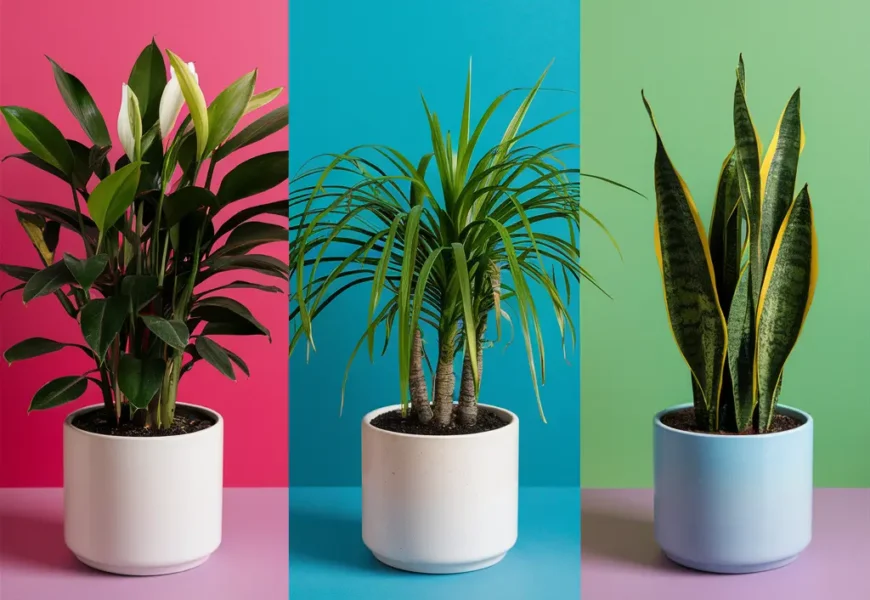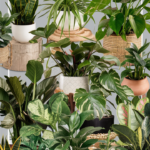Are you someone who’s always on the go, with a packed schedule and little time to spare? Does the idea of caring for indoor plants seem like just another item on an already overflowing to-do list? Don’t worry, you’re not alone. Many of us lead busy lives, juggling work, family, and social commitments, leaving little room for plant care.
But here’s the good news: you can still enjoy the benefits of greenery in your home without adding extra stress to your daily routine. Introducing three indoor plants that not only thrive on a daily splash of water but practically take care of themselves!
The Challenge of Busy Lifestyles
In today’s fast-paced world, finding time for plant care can be a challenge. With work deadlines looming, family responsibilities calling, and social engagements filling up our calendars, the thought of nurturing indoor plants may seem like a daunting task. Watering, pruning, and ensuring the right amount of sunlight can quickly become overwhelming for those with busy schedules.
The Solution: Self-Sufficient Indoor Plants
Luckily, there’s a solution for busy individuals who still want to enjoy the beauty and benefits of indoor plants. By choosing varieties that require minimal maintenance and thrive with little intervention, you can create a lush, green oasis in your home without the added stress.
Introducing: Peace Lily, Spider Plant, and Snake Plant
These three indoor plants are not only aesthetically pleasing but also incredibly resilient, making them perfect companions for busy bees like yourself. Let’s take a closer look at each one:
Each of these plants has unique qualities that make them ideal for busy households. From their ability to thrive in low-light conditions to their efficient water-retention mechanisms, they offer the perfect solution for plant lovers with hectic lifestyles.
In the following sections, we’ll delve deeper into the characteristics of each plant, exploring their care requirements and highlighting why they’re the perfect choice for those who are short on time but still want to enjoy the benefits of indoor gardening.
But first, let’s take a moment to appreciate the growing trend of incorporating greenery into our homes, even amidst our busy schedules. If you’re interested in exploring more about the latest houseplant trends and gardening hacks, be sure to check out our related articles:
- Top 10 Houseplant Trends to Spruce Up Your Home in 2024
- 20 Gardening Hacks for Happy and Thriving Plants
- Breathe Easy: Beautify Your Living Room – Top Plants for a Healthy, Happy Home
Now, let’s dive into the world of low-maintenance indoor plants and discover how you can effortlessly incorporate greenery into your busy life.
1. Peace Lily
The Peace Lily, with its elegant white blooms and lush green leaves, is not only a beautiful addition to any indoor space but also a low-maintenance plant that thrives on neglect. Here’s why it’s the perfect choice for busy individuals:
Characteristics
- Foliage: The Peace Lily features glossy, dark green leaves that add a touch of elegance to any room.
- Flowers: Its striking white flowers, often mistaken for blooms, can last for weeks, adding a burst of color to your home.
- Size: Peace Lilies come in various sizes, making them suitable for both small apartments and larger living spaces.
Ideal Growing Conditions
- Light: While Peace Lilies prefer bright, indirect light, they can tolerate low-light conditions, making them versatile for different areas of your home.
- Temperature: They thrive in temperatures between 65-80°F (18-27°C) and are sensitive to cold drafts.
- Humidity: These plants enjoy high humidity levels, making bathrooms an ideal location for them.
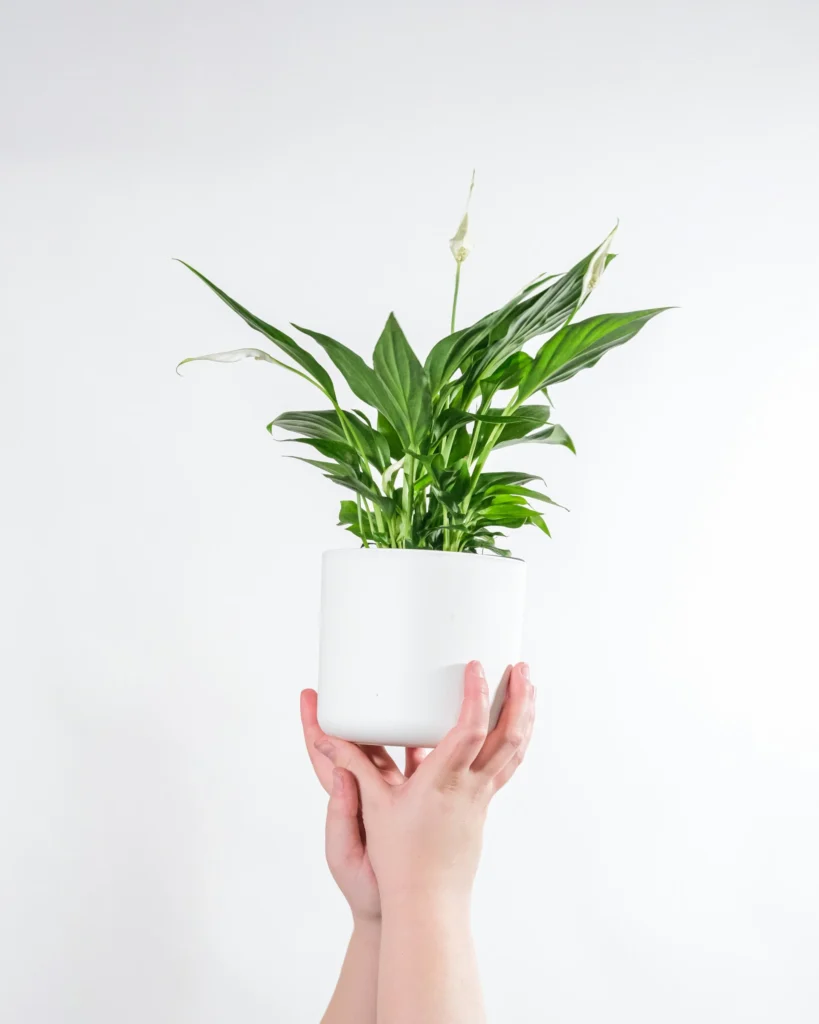
Watering Requirements
- Frequency: Peace Lilies prefer consistently moist soil but can tolerate occasional drying out between waterings.
- Indicator: They will droop slightly when they need water, making it easy to know when it’s time to water.
- Self-Maintenance: Peace Lilies have a built-in mechanism for self-regulating water intake, making them forgiving of occasional neglect.
Care Tips
- Repotting: Repotting every year or two allows Peace Lilies to continue thriving and prevents them from becoming root-bound.
- Fertilization: Feed with a balanced liquid fertilizer during the growing season to encourage healthy growth and flowering.
- Pest Control: Keep an eye out for pests like spider mites and mealybugs, especially in dry indoor environments.
With its graceful appearance and minimal care requirements, the Peace Lily is the perfect choice for busy individuals who want to enjoy the beauty of indoor plants without the hassle of frequent maintenance. Next, let’s explore another resilient plant that thrives on neglect: the Spider Plant.
2. Spider Plant
The Spider Plant, known for its long, arching leaves and easy-care nature, is a favorite among indoor gardeners for its resilience and air-purifying qualities. Here’s why it’s an excellent choice for busy individuals:
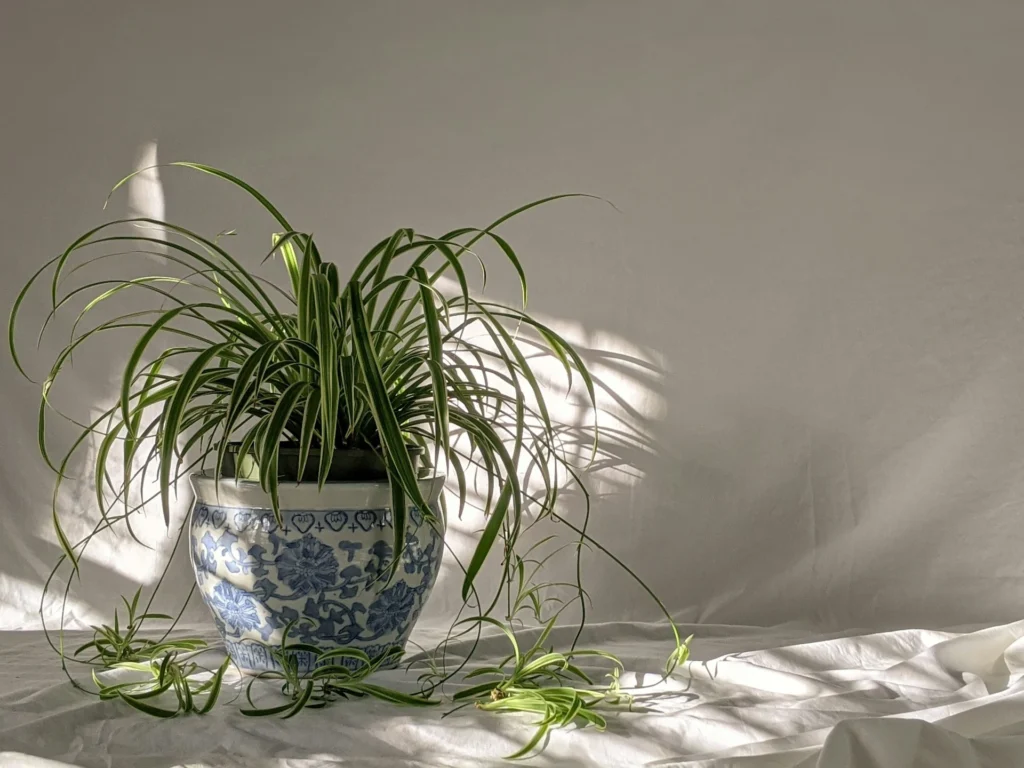
Characteristics
- Foliage: Spider Plants feature long, narrow leaves that arch gracefully, giving them a spider-like appearance.
- Offsets: They produce baby plants, or offsets, that dangle from the parent plant, adding visual interest.
- Varieties: There are different varieties of Spider Plants, including variegated and solid green varieties.
Ideal Growing Conditions
- Light: Spider Plants thrive in bright, indirect light but can also tolerate low-light conditions, making them versatile for various locations in your home.
- Temperature: They prefer temperatures between 60-75°F (15-24°C) and can tolerate slightly cooler temperatures.
- Watering: Spider Plants prefer consistently moist soil but can tolerate occasional drying out between waterings.
Watering Requirements
- Frequency: Water Spider Plants when the top inch of soil feels dry to the touch.
- Indicator: They will start to droop when they need water, but they recover quickly once watered.
- Self-Maintenance: Spider Plants have tuberous roots that store water, allowing them to withstand periods of neglect.
Care Tips
- Propagation: Spider Plants are easy to propagate by planting the offsets in potting soil or water until roots develop.
- Pruning: Remove any brown or damaged leaves regularly to encourage new growth.
- Pest Control: Keep an eye out for common indoor pests like aphids and spider mites, especially in dry indoor environments.
With its graceful foliage and ability to thrive in a variety of conditions, the Spider Plant is an excellent choice for busy individuals looking to add greenery to their homes without the hassle of frequent maintenance. Next, let’s explore another low-maintenance plant that can thrive on neglect: the Snake Plant.
3. Snake Plant
The Snake Plant, also known as Mother-in-Law’s Tongue, is a hardy and visually striking plant known for its upright, sword-like leaves and low-maintenance nature. Here’s why it’s a perfect choice for busy individuals:
Characteristics
- Foliage: Snake Plants feature tall, stiff leaves that grow upright, adding a sculptural element to any indoor space.
- Varieties: There are several varieties of Snake Plants available, with different leaf colors and patterns, including variegated and solid green varieties.
- Air Purification: Snake Plants are renowned for their air-purifying abilities, making them an excellent choice for improving indoor air quality.
Ideal Growing Conditions
- Light: Snake Plants are adaptable and can thrive in a wide range of light conditions, from bright, indirect light to low light.
- Temperature: They prefer temperatures between 60-85°F (15-29°C) and are tolerant of fluctuations in temperature.
- Watering: Snake Plants are drought-tolerant and prefer to dry out between waterings, making them perfect for forgetful or busy plant owners.
Watering Requirements
- Frequency: Water Snake Plants sparingly, allowing the soil to dry out completely between waterings.
- Indicator: The leaves may slightly wilt when the plant needs water, but they will quickly recover once watered.
- Self-Maintenance: Snake Plants have thick, fleshy leaves that store water, allowing them to survive extended periods without watering.
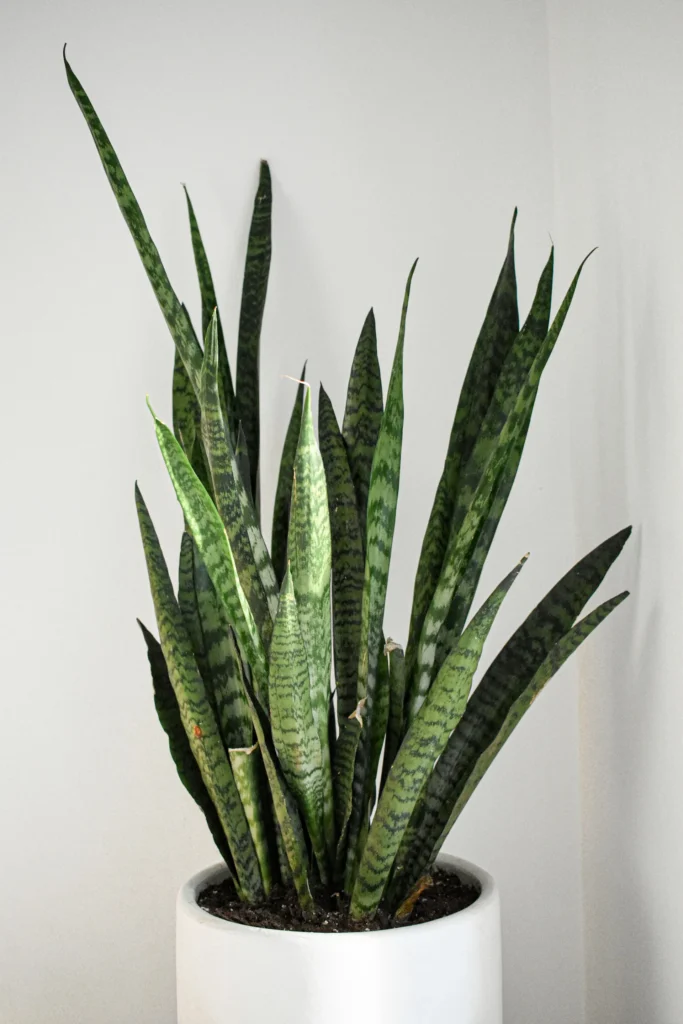
Care Tips
- Repotting: Repot Snake Plants every few years to refresh the soil and prevent overcrowding of roots.
- Propagation: Snake Plants can be propagated easily by dividing the rhizomes or by leaf cuttings in water or soil.
- Pest Control: While Snake Plants are relatively pest-resistant, monitor for signs of pests like mealybugs or spider mites, especially in dry indoor environments.
If you’re interested in exploring more about houseplants and indoor gardening, be sure to check out our related articles:
- Breathe Easy: Beautify Your Living Room – Top Plants for a Healthy, Happy Home
- Keep Calm and Plant On: A Guide to Safe, Stylish Houseplants
- Pets and Plants: Happy Home Hacks for You & Your Dog
With its striking appearance and minimal care requirements, the Snake Plant is an excellent choice for busy individuals seeking to enhance their indoor environment with greenery. Whether placed in a bright corner or a dimly lit room, this resilient plant is sure to thrive with minimal intervention.
Incorporating Self-Watering Planters for Added Convenience
While the Peace Lily, Spider Plant, and Snake Plant are already low-maintenance options for indoor gardening, busy individuals can take their plant care routine to the next level by utilizing self-watering planters. These innovative containers come with built-in reservoirs that provide a constant water supply to the plants, reducing the frequency of manual watering and ensuring consistent moisture levels. Here’s how incorporating self-watering planters can further simplify your indoor gardening experience:
- Consistent Moisture Levels: Self-watering planters maintain optimal moisture levels in the soil, preventing both under-watering and over-watering, which are common pitfalls for busy plant owners.
- Extended Watering Intervals: With a self-watering planter, you can extend the time between watering sessions, allowing you to focus on other tasks without worrying about your plants drying out.
- Plant Health: By providing a steady supply of water to the roots, self-watering planters promote healthier growth and reduce the risk of stress-related issues such as wilting or leaf yellowing.
- Ideal for Travelers: If you frequently travel or are planning a vacation, self-watering planters offer peace of mind knowing that your plants will receive the hydration they need in your absence.
- Variety of Designs: Self-watering planters come in various sizes, styles, and materials to suit your aesthetic preferences and indoor decor. Whether you prefer sleek modern designs or rustic terracotta pots, there’s a self-watering planter to complement any space.
By combining the low-maintenance nature of the Peace Lily, Spider Plant, and Snake Plant with the convenience of self-watering planters, you can create an indoor garden that thrives with minimal effort. To learn more about the benefits of self-watering planters and how to choose the right option for your needs, check out our comprehensive guide: The Easy Guide to Self-Watering Houseplants.
In conclusion, busy individuals don’t have to sacrifice the joy of indoor gardening due to their hectic schedules. With the right selection of low-maintenance plants like the Peace Lily, Spider Plant, and Snake Plant, paired with self-watering planters for added convenience, anyone can enjoy the beauty and benefits of greenery in their home, hassle-free.
So go ahead, embrace the tranquility of nature indoors and let your busy life thrive alongside your thriving plants!
Conclusion
In a world filled with hustle and bustle, it’s essential to create spaces that offer moments of tranquility and rejuvenation. Indoor gardening provides a perfect opportunity to reconnect with nature and cultivate a sense of calm within your home, even amidst a busy lifestyle.
By choosing low-maintenance plants like the Peace Lily, Spider Plant, and Snake Plant, you can enjoy the beauty of greenery without the added stress of frequent care. These resilient plants not only enhance the aesthetics of your indoor environment but also contribute to improved air quality and overall well-being.
Incorporating self-watering planters further simplifies the indoor gardening experience, offering convenience and peace of mind for busy individuals. With consistent moisture levels and extended watering intervals, you can confidently nurture your plants while focusing on other priorities in your life.
As you embark on your indoor gardening journey, remember that it’s not just about the plants—it’s about creating a nurturing environment that nurtures your soul. Take the time to observe and connect with your plants, and you’ll discover the therapeutic benefits of tending to your indoor garden.
To continue exploring the world of indoor gardening and discover more tips and tricks for plant care, be sure to check out our related articles:
- Houseplant Parenthood Made Easy: 10 Tips for Beginners to Thrive
- Breathe Easy: Live Green – Unleash the Power of Indoor Gardening
- Thrive Indoors: 5 Foolproof Tips to Keep Your Houseplants Happy
So, whether you’re a seasoned plant enthusiast or just beginning your journey into indoor gardening, remember that the joy of greenery is accessible to everyone, regardless of how busy life may get. Embrace the tranquility of indoor gardening, and let your home flourish with vibrant, thriving plants.
FAQ
How often should I water my indoor plants?
- Answer: The frequency of watering depends on factors such as the plant species, environmental conditions, and the type of potting mix used. As a general rule of thumb, it’s best to water your indoor plants when the top inch of soil feels dry to the touch. Overwatering can lead to root rot, so always check the soil moisture before watering.
Can I use tap water to water my indoor plants?
- Answer: Tap water can be used to water most indoor plants, but it’s essential to consider the quality of your tap water and the specific needs of your plants. Some plants may be sensitive to chemicals like chlorine or fluoride found in tap water, so it’s a good idea to let the water sit for 24 hours before using it to allow any chlorine to dissipate. Alternatively, you can use filtered or distilled water for sensitive plants.
How much sunlight do indoor plants need?
- Answer: The amount of sunlight required varies depending on the plant species. While some plants thrive in bright, indirect light, others can tolerate low-light conditions. Before purchasing a plant, consider the lighting conditions in your home and choose species that are suited to those conditions. You can also rotate your plants periodically to ensure they receive even light distribution.
What are the benefits of using self-watering planters?
- Answer: Self-watering planters offer several benefits for busy individuals or those prone to forgetting to water their plants regularly. These planters have built-in reservoirs that provide a steady supply of water to the plants, reducing the frequency of manual watering and ensuring consistent moisture levels. They can also help prevent overwatering, as the plants can absorb water as needed from the reservoir.
How do I know if my indoor plant is getting enough water?
- Answer: Signs of underwatering include wilting, yellowing leaves, and dry, crispy foliage. On the other hand, overwatering can lead to root rot, mushy stems, and yellowing leaves. To ensure your indoor plants are receiving the right amount of water, regularly check the soil moisture level and observe any changes in the plant’s appearance. Adjust your watering frequency accordingly.
Can I fertilize my indoor plants during the winter months?
- Answer: While indoor plants generally experience slower growth during the winter months due to reduced light levels and lower temperatures, they can still benefit from occasional fertilization. However, it’s essential to use a diluted fertilizer and apply it sparingly to avoid overfeeding the plants. Follow the recommendations on the fertilizer label and reduce the frequency of fertilization compared to the growing season.
How do I prevent pests from infesting my indoor plants?
- Answer: To prevent pests from infesting your indoor plants, practice good plant hygiene by regularly inspecting your plants for signs of pests, such as webbing, sticky residue, or chewed leaves. Remove any affected plant parts immediately and isolate infested plants to prevent the pests from spreading. Additionally, avoid overwatering and overcrowding your plants, as these conditions can attract pests.
What are some pet-friendly indoor plants?
- Answer: Some pet-friendly indoor plants that are safe for cats and dogs include spider plants, Boston ferns, African violets, and air plants. It’s essential to research each plant’s toxicity level before bringing it into your home, as some common houseplants can be harmful to pets if ingested. Consider placing plants out of reach of curious pets or opting for hanging planters to prevent accidental consumption.
How can I improve the humidity levels for my indoor plants?
- Answer: Increasing humidity levels can benefit many indoor plants, especially tropical species that thrive in humid environments. You can improve humidity levels by placing a tray of water near your plants, using a humidifier, or grouping plants together to create a microclimate with higher humidity. Misting your plants with water can also help temporarily increase humidity levels, but be cautious not to overdo it, as excessive moisture can lead to fungal diseases.

